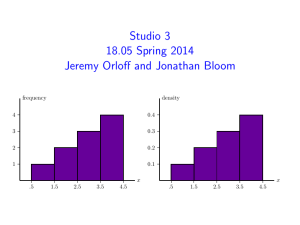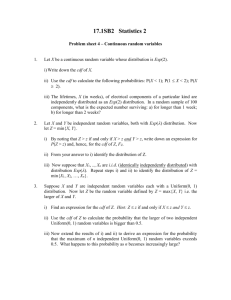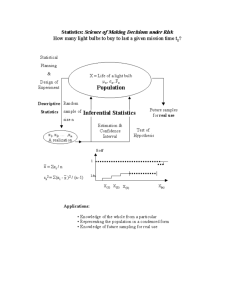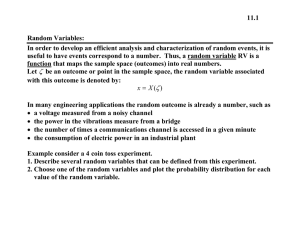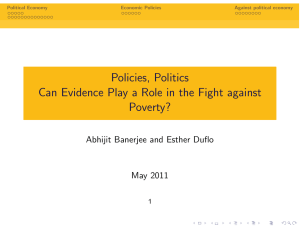Document 13436904
advertisement
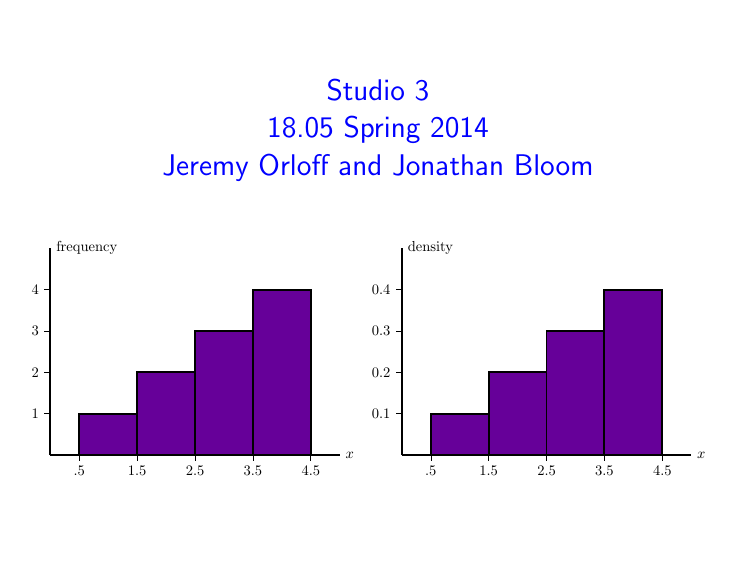
Studio 3 18.05 Spring 2014 Jeremy Orloff and Jonathan Bloom frequency density 4 0.4 3 0.3 2 0.2 1 0.1 x .5 1.5 2.5 3.5 4.5 x .5 1.5 2.5 3.5 4.5 Concept questions Suppose X is a continuous random variable. a) What is P(a ≤ X ≤ a)? b) What is P(X = 0)? c) Does P(X = 2) = 0 mean X never equals 2? answer: a) 0 b) 0 c) No. For a continuous distribution any single value has probability 0. Only a range of values has non-zero probability. July 13, 2014 2 / 11 Concept question Which of the following are graphs of valid cumulative distribution functions? Add the numbers of the valid cdf’s and click that number. answer: Test 2 and Test 3. July 13, 2014 3 / 11 Solution Test 1 is not a cdf: it takes negative values, but probabilities are positive. Test 2 is a cdf: it increases from 0 to 1. Test 3 is a cdf: it increases from 0 to 1. Test 4 is not a cdf: it decreases. A cdf must be non-decreasing since it represents accumulated probability. July 13, 2014 4 / 11 Exponential Random Variables Parameter: λ (called the rate parameter). Range: [0, ∞). Notation: Density: Models: exponential(λ) or exp(λ). f (x) = λe−λx for 0 ≤ x. Waiting time P (3 < X < 7) .1 1 F (x) = 1 − e−x/10 x 2 4 6 8 10 12 14 16 x 2 4 6 8 10 12 14 16 Continuous analogue of geometric distribution –memoryless! July 13, 2014 5 / 11 Uniform and Normal Random Variables Uniform: U(a, b) or uniform(a, b) Range: [a, b] 1 PDF: f (x) = b−a Normal: N(µ, σ 2 ) Range: (−∞, ∞] 1 2 2 PDF: f (x) = √ e−(x−µ) /2σ σ 2π http://web.mit.edu/jorloff/www/18.05/applets/ probDistrib.html July 13, 2014 6 / 11 Table questions Open the applet http://web.mit.edu/jorloff/www/18.05/applets/ probDistrib.html 1. For the standard normal distribution N(0, 1) how much probability is within 1 of the mean? Within 2? Within 3? 2. For N(0, 32 ) how much probability is within σ of the mean? Within 2σ? Within 3σ. 3. Does changing µ change your answer to problem 2? July 13, 2014 7 / 11 Normal probabilities within 1 · σ ≈ 68% Normal PDF within 2 · σ ≈ 95% within 3 · σ ≈ 99% 68% 95% 99% −3σ −2σ −σ σ 2σ 3σ z Rules of thumb: P(−1 ≤ Z ≤ 1) ≈ .68, P(−2 ≤ Z ≤ 2) ≈ .95, P(−3 ≤ Z ≤ 3) ≈ .997 July 13, 2014 8 / 11 Download R script Download studio3.zip and unzip it into your 18.05 working directory. Open studio3.r in RStudio. July 13, 2014 9 / 11 Histograms Will discuss in more detail in class 6. Made by ‘binning’ data. Frequency: height of bar over bin = # of data points in bin. Density: area of bar over bin is proportional to # of data points in bin. Total area of a density histogram is 1. frequency density 4 0.4 3 0.3 2 0.2 1 0.1 x .5 1.5 2.5 3.5 4.5 x .5 1.5 2.5 3.5 4.5 July 13, 2014 10 / 11 Histograms of averages of exp(1) 1. Generate a frequency histogram of 1000 samples from an exp(1) random variable. 2. Generate a density histogram for the average of 2 independent exp(1) random variable. 3. Using rexp(), matrix() and colMeans() generate a density histogram for the average of 50 independent exp(1) random variables. Make 10000 sample averages and use a binwidth of .1 for this. Look at the spread of the histogram. 4. Superimpose a graph of the pdf of N(1, 1/50) on your plot in problem 3. (Remember the second parameter in N is σ 2 .) Code for the solutions is at http://web.mit.edu/jorloff/www/18.05/r-code/studio3-sol.r July 13, 2014 11 / 11 0,72SHQ&RXUVH:DUH KWWSRFZPLWHGX ,QWURGXFWLRQWR3UREDELOLW\DQG6WDWLVWLFV 6SULQJ )RULQIRUPDWLRQDERXWFLWLQJWKHVHPDWHULDOVRURXU7HUPVRI8VHYLVLWKWWSRFZPLWHGXWHUPV
